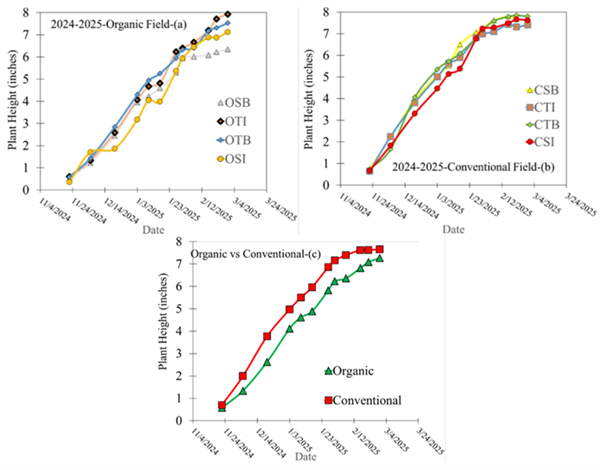Lettuce is one of the most important vegetable crops in the Yuma, Arizona region. However, growing healthy lettuce in the desert isn’t easy. High temperatures, salty soils, and very low rainfall (less than 3 inches per year) make crop management especially difficult. Growers are always looking for better tools to improve crop growth while saving water and reducing input costs.
Biostimulants are one such tool. These are natural products often made from seaweed extracts, organic acids, or beneficial microbes that are added to the soil or irrigation water. They don’t replace fertilizers, but they can help plants grow better by improving how roots absorb nutrients and handle stress like heat, drought, or poor soil quality.
Our Trial in Yuma, AZ
To better understand whether biostimulants can help desert lettuce crops, we conducted a field trial during the 2024–2025 growing season at the University of Arizona’s Valley
Research Center in Yuma. The field was managed using subsurface drip irrigation, a water-saving system that delivers moisture directly to the plant roots below the soil surface. We tested a commercially available biostimulant made from organic compounds and micronutrients known to support root and shoot growth.
The trial included several treatments, some with biostimulant and some without, under both traditional and sensor-based irrigation scheduling. We tracked plant height every two weeks to monitor lettuce growth and compared results between the treated and untreated plots.
What We Found
In the organic lettuce trial, biostimulant use did not result in a clear or measurable increase in plant height. All treatments (Figure 1), whether biostimulant was applied or not, showed similar growth patterns and reached comparable final heights by the end of the season. In the conventional lettuce trial, the tallest plants appeared in the biostimulant-treated plots; however, the difference compared to untreated plots was small and not statistically significant. When the data from both systems were combined, conventional treatments consistently produced taller plants than organic ones, regardless of biostimulant application. These findings suggest that biostimulant effects on plant height are minimal and highly dependent on the production system and environmental or management factors.
Takeaway
Biostimulants may not be a magic solution for crop growth and development, but they offer promise as part of an integrated crop management strategy. In desert systems where water is limited and soils can be harsh, even modest improvements in plant growth can help growers increase their productivity and resilience.

Figure 1. Distribution of plant height: (a) Organic Field; Organic sensor-based irrigation +
biostimulant (OSB), Organic traditional-based irrigation (OTI), Organic traditional-based
irrigation + biostimulant (OTB), and Organic sensor-based irrigation (OSI); (b)
Conventional Field; Conventional sensor-based irrigation + biostimulant (CSB),
Conventional traditional-based irrigation (CTI), Conventional traditional-based irrigation +
biostimulant (CTB), and Conventional sensor-based irrigation (CSI); (c) Pooled data for
Organic and Conventional Field treatments. Each data point represents the average of
10 readings collected in the field at the Valley Research Center, University of Arizona,
Yuma Agricultural Center, Yuma, Arizona.






